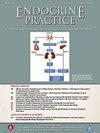比较2型糖尿病患者出院后持续血糖监测和毛细血管血糖检测的随机研究。
IF 3.7
3区 医学
Q2 ENDOCRINOLOGY & METABOLISM
引用次数: 0
摘要
目的:连续血糖监测(CGM)在治疗住院2型糖尿病(T2D)患者高血糖中的益处已在观察和干预临床研究中得到证实。然而,出院后CGMs在改善T2D患者护理方面的益处尚不清楚。方法:本试点随机临床试验旨在比较使用FreeStyle Libre 2 CGM与毛细血管即时血糖检测(POC)在胰岛素治疗的T2D患者出院后长达12周的有效性和安全性。我们评估了与使用FreeStyle Libre 2型CGM相关的安全性(低血糖)、有效性(平均每日血糖)和医疗保健利用(急诊室就诊和住院),并与出院后的毛细血管POC检测进行了比较。结果:在100名参与者中(平均年龄54.3±10.7岁,糖化血红蛋白10.46±2.24%,中位糖尿病病程9.0年,IQR 1.0, 42),两组出院时基线临床特征无显著差异。我们观察到,与POC组相比,CGM组有改善血糖控制的趋势,包括在70-180 mg/dl范围内的时间(TIR)增加,在180和250 mg/dl范围内的时间(TAR)减少,出院后低血糖和胰岛素需求减少。在急诊室就诊和住院方面,研究小组之间没有差异。结论:本初步研究结果表明,与POC血糖检测相比,使用CGM可改善出院后血糖控制,减少低血糖,降低血糖变异性。Clinicaltrials: gov ID #: 05822232。本文章由计算机程序翻译,如有差异,请以英文原文为准。
Randomized Study Comparing Continuous Glucose Monitoring and Capillary Glucose Testing in Patients With Type 2 Diabetes After Hospital Discharge
Objective
The benefits of continuous glucose monitoring (CGM) in managing hyperglycemia in hospitalized patients with type 2 diabetes (T2D) have been documented in observation and intervention clinical studies. However, the benefits of CGMs after hospital discharge in improving the care of patients with T2D remain unknown.
Methods
This pilot randomized clinical trial aimed to compare the effectiveness and safety of using the FreeStyle Libre 2 CGM vs capillary point-of-care (POC) glucose testing (standard of care) in insulin-treated patients with T2D for up to 12 weeks after hospital discharge. We assessed safety (hypoglycemia), efficacy (mean daily glucose), and healthcare utilization (emergency room visits and hospital admissions) associated with the use of FreeStyle Libre 2 CGM compared to capillary POC testing following hospital discharge.
Results
Among 100 participants (mean age 54.3 ± 10.7 years, HbA1c 10.46 ± 2.24%, median diabetes duration of 9.0 years, IQR 1.0, 42), there were no significant differences in baseline clinical characteristics between the groups at discharge. We observed a trend toward improved glycemic control in the CGM group, including increased time in range 70-180 mg/dl, reduced time above range > 180 and 250 mg/dl, and decreased hypoglycemia and insulin requirements after discharge compared to the POC group. There were no differences in emergency room visits or hospitalization between the study groups.
Conclusion
The results of this pilot study indicate that the use of CGM leads to improved glycemic control, reduced hypoglycemia, and decreased glucose variability compared to POC glucose testing after hospital discharge.
求助全文
通过发布文献求助,成功后即可免费获取论文全文。
去求助
来源期刊

Endocrine Practice
ENDOCRINOLOGY & METABOLISM-
CiteScore
7.60
自引率
2.40%
发文量
546
审稿时长
41 days
期刊介绍:
Endocrine Practice (ISSN: 1530-891X), a peer-reviewed journal published twelve times a year, is the official journal of the American Association of Clinical Endocrinologists (AACE). The primary mission of Endocrine Practice is to enhance the health care of patients with endocrine diseases through continuing education of practicing endocrinologists.
 求助内容:
求助内容: 应助结果提醒方式:
应助结果提醒方式:


